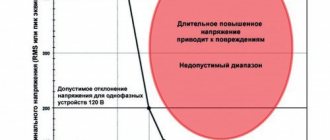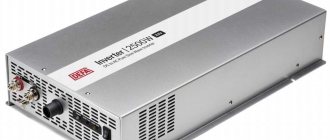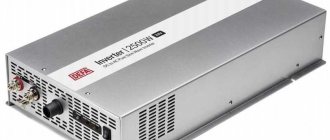| Voltage class of electrical equipment, kV | Highest operating voltage of electrical equipment, kV | Rated voltage of the electrical network, kV | Maximum long-term permissible operating voltage of the electrical network, kV |
| 3,6 | 3,0 | 3,5 | |
| 3,158 | 3,5 | ||
| 3,3 | 3,6 | ||
| 7,2 | 6,0 | 6,9 | |
| 6,6 | 7,2 | ||
| 12,0 | 10,0 | 11,5 | |
| 11,0 | 12,0 | ||
| 17,5 | 13,8 | 15,2 | |
| 15,0 | 17,5 | ||
| 15,75 | 17,5 | ||
| 24,0 | 18,0 | 19,8 | |
| 20,0 | 23,0 | ||
| 22,0 | 24,0 | ||
| 26,6 | 24,0 | 26,5 | |
| 30,0 | 27,0 | 30,0 | |
| 40,5 | 35,0 | 40,5 | |
| 126,0 | 110,0 | 126,0 | |
| 172,0 | 150,0 | 172,0 | |
| 252,0 | 220,0 | 252,0 | |
| 363,0 | 330,0 | 363,0 | |
| 525,0 | 500,0 | 525,0 | |
| 787,0 | — | — | |
| 1200,0 | — | — |
The excess of the operating voltage over the rated voltage of the low voltage winding in percentage is approximately equal to the value of overexcitation of the rod and can be monitored by the readings of the panel kilovoltmeter of the low voltage windings.
Overexcitation of the magnetic circuit yoke can be monitored by the difference in readings of panel kilovoltmeters of the high and medium voltage windings. The excess of this difference over its nominal value in percentage is equal, with acceptable accuracy, to the value of the overexcitation of the yoke.
5.3.14. For oil transformers, a long-term overcurrent of any winding is allowed by 5% of the rated branch current, if the voltage on the branch does not exceed the rated one.
In addition, for transformers, depending on the operating mode, systematic overloads are allowed, the value and duration of which are regulated by the standard operating instructions for transformers and the manufacturers' instructions.
In autotransformers, to the low voltage windings of which a generator, synchronous compensator or load is connected, the current control of the common part of the high voltage winding must be organized.
The service life of a transformer is determined mainly by the aging of the organic insulation of the windings. Thermal aging of winding insulation is determined by the temperature at which the insulation operates and the duration of its exposure. GOST 11667-85 normalizes the design service life of a transformer insulation when operating with a constant rated load under nominal temperature conditions (at an average annual ambient temperature of about 20 °C) - 25 years. This corresponds to a constant average winding temperature of 85 °C and a temperature of the hottest point of the winding of 98 °C.
In real operating conditions, the load on transformers varies both during the day and throughout the year. Based on the conditions of reliable operation, oil transformers allow long-term overload of each winding with a current exceeding no more than 5% of the rated current, if the voltage on none of the windings exceeds the rated one. In this case, for a winding with branches, the load should not exceed 1.05 of the rated branch current, unless the transformer is operated with systematic overloads specified below.
Systematic overloads of transformers are allowed depending on the nature of the daily load schedule, the temperature of the cooling medium and underload in the summer.
The permissible overload value and its duration for oil transformers with a power of up to 100 MV-A are established according to load capacity graphs in accordance with GOST 14209-85. These instructions also apply to transformers with a capacity of more than 100 MV-A, unless there are other instructions on load capacity in the technical specifications or manufacturer's instructions.
Dry transformers allow systematic overloads in accordance with the factory instructions or technical specifications for a given transformer.
Systematic transformer overloads should not exceed 50% of the rated power. Systematic overloads of more than 1.5 times the rated current can only be allowed by agreement with the manufacturer.
In addition to the above, overloads of transformers manufactured in accordance with GOST 11677-65 before July 1, 1970, equipped with inputs for a voltage of 110 kV and higher, as well as inputs for lower voltages with a rated current of 3000 A or more, are allowed with a current not more than 10% higher than the rated current of the specified inputs.
The evolution of network voltage - where it all began
The level of standard voltages has constantly changed over the past 100 years for domestic household networks, depending on the degree of technological development. Thus, at the dawn of the electrification of the countries of the Soviet camp, a nominal value of 127 V was set for consumers of electrical energy. This system of nominal parameters came into use thanks to the developments of Dolivo-Dobrovolsky, who proposed three-phase generation instead of the outdated two-phase. It should be noted that back in the late 30s of the last century, the voltage standard of 127 V already poorly corresponded to the increased production needs, it was then that the first attempts to replace it arose, but with the outbreak of World War II, these plans were never realized.
But already in the 60s, large-scale work began to bring the rated voltage to the new standard 220/380 V instead of three-phase alternating 127/220 V. European networks, by that time, had already made a massive transition to new ratings in order to avoid unreasonably costly replacement of wires with larger section. In an attempt to remain as efficient as possible, the Soviet countries also began a transition that was planned to be completed within the next five years. There was construction of new power plants, replacement of transformers and power units, but the process of transition to standards of 220 V phase voltage for household consumers dragged on until the 80s.
Rice. 1. Rating on the socket
In 1992, GOST 29322-92 (IEC 38-83) introduced new voltage standards: 230 V phase instead of 220 V and 400 V linear instead of the usual 380 V.
This step was pursued by the desire to bring our own energy system on par with foreign ones for:
- convenience of working with immediate neighbors;
- opportunities for unhindered access to world markets;
- simplifying the transit procedure.
But, due to the imperfection of the entire domestic power supply system and the lack of funds for full-scale reconstruction, these voltage standards have not been established to this day.
What does rating mean?
rated parameters - Parameters (voltage, current, etc.), the values of which determine the operation of the transformer in rated mode.
Interesting materials:
How long does it take to charge a new phone? How to get it from the clipboard on your phone? How to get contacts from a broken Android phone? How to remove a SIM card from a Sony Xperia phone? How to call Europe Plus from a mobile phone? How to mirror your phone screen to a laptop via USB? How to duplicate your phone screen to a laptop? How to mirror your phone screen to LG TV? How to mirror your phone screen to Samsung TV? How to mirror your phone screen to a Sony TV?
Disagreements in GOSTs
How can it be that there are norms, new requirements are given in the standard, but practical implementation has not come even after almost thirty years. The reason for this was the constant increase in the power of household appliances, their number and growing consumption. Therefore, power supply organizations could not even achieve the permissible deviations of the previous standard rated voltage.
The first of the standards under consideration is GOST 3244-2013 , intended to determine the main parameters of the quality of electrical energy. As one of these indicators, the standard establishes acceptable ranges for potential differences.
Of course, it makes no sense to consider all the points and their calculation part, so we will discuss the most important points:
- according to clause 4.2.2, the rated voltage is considered to be 220 V between phase and zero, and 380 V for the linear norm.
- voltage dips, which, as a rule, are caused by the introduction of powerful consumers, the duration of the dip should not exceed 1 minute;
- in accordance with clause 4.3.3, pulse overvoltages, which can be caused by atmospheric discharges, range from 1 microsecond to several milliseconds;
- the asymmetry of the three-phase network according to clause 4.2.5 should be no more than 2 - 4% of the asymmetry coefficient in a ten-minute interval according to the weekly characteristic.
GOST 29322-2014 is in force , which refers to international standards and establishes the nominal characteristics of voltage series. It was developed in accordance with other standards - IEC 60038:2009 and repealed the 1992 standard. But in it, according to clause 3.1, the rating of household energy networks is set at 230 V and 400 V for electrical networks with alternating current with a frequency of 50 Hz. It is worth saying that for foreign networks with a frequency of 60 Hz there are some differences, but the permissible frequency deviation is only 2%, so these amendments are irrelevant for domestic consumers.
Preface
1 DEVELOPED by the Joint Stock Company "System Operator of the Unified Energy System"
2 INTRODUCED by the Technical Committee for Standardization TK016 “Electric Power Industry”
3 APPROVED AND ENTERED INTO EFFECT by Order of the Federal Agency for Technical Regulation and Metrology dated January 16, 2022 No. 12-st
4 INTRODUCED FOR THE FIRST TIME
The rules for applying this standard are established in Article 26 of the Federal Law of June 29, 2015 N9 162-FZ “On Standardization in the Russian Federation”. Information about changes to this standard is published in the annual (as of January 1 of the current year) information index “National Standards”, and the official text of changes and amendments is published in the next issue of the monthly information index “National Standards”. In case of revision (replacement) or cancellation of this standard, the corresponding notice will be published in the next issue of the monthly information index “National Standards”. Relevant information, notifications and texts are also posted in the public information system - on the official website of the Federal Agency for Technical Regulation and Metrology on the Internet ()
© Sgandartinform.2017
This standard cannot be fully or partially reproduced, replicated or distributed as an official publication without permission from the Federal Agency for Technical Regulation and Metrology
GOST R 57382—2017
How to try on two regulatory documents?
Despite the inconsistencies described above, both standards allow a possible deviation of characteristics from the nominal value by 10%, both up and down. However, note that the 220 V rating will allow a voltage deviation ranging from 198 V to 242 V. At the same time, the new 230 V rating will have a variation of 207 V to 253 V between the possible minimum and maximum in the outlet.
To even out the discrepancy between different standards, GOST 29322-2014 provides the following voltage options for 230 V networks in Table A.1:
- nominal – 230 V:
- the highest used for power supply is 253 V;
- the smallest for power supply is 207 V;
- the smallest used is 198 V.
As you can see, here the lower limit of the permissible voltage norm has been expanded to 198 V, which is necessary as one of the stages in the evolution of the old domestic system to modern standards. Thus, the new standards do not exclude 220 V, but include them as an acceptable deviation from the international standard, to which domestic power supply organizations have not yet switched due to certain circumstances.
LED strip voltage
LED strips use the same LEDs as lamps, so everything written above also applies to them, i.e. The operating voltage for the strip LED is 2-3.2 V.
To summarize, it is worth noting that each LED has its own individual characteristics, including voltage. In order to find out exactly how much a particular light-emitting diode is designed for, you need to read its manual, the so-called Datasheet.
Summing up
As you can see, the 220 V voltage is a relic of the old system, which is still allowed in your sockets as a private option, as a derivative of the 230 V rating. But as for the spread from minimum to maximum, you should be especially careful here. The thing is that most manufacturers produce household equipment for certain voltage limits, for example from 200 to 240 V, so if the potential difference increases to 250 V, which is acceptable, the device may simply fail.
If you have a similar situation in your apartment, you can follow a simple procedure:
- check the norm on the device you are interested in;
Rice. 2: Check the voltage standard
- measure the voltage at the outlet;
Rice. 3. Measure the voltage in the network
- compare these values.
If the network voltage is significantly higher than the permissible voltage for the device, you will need a stabilizer or a new device. If the voltage rating in the network is higher than that allowed by GOST, then urgently contact the energy supply organization.
conclusions
The cable voltage should first of all be selected based on the maximum voltage in the system. The maximum voltage for which the cable is rated must be greater than or equal to the maximum system voltage
Um.cable ≥ Um.network
Next, you need to understand the operating mode of the network. If the network operates with an isolated neutral (like most 6-35 kV networks), then it is necessary to determine the length of time during which the system can operate in single-phase earth fault mode.
Next, according to Table 1, U0 of the cable is selected, corresponding to the network operating mode. If the network in terms of operating mode belongs to category C, then a cable with a higher U0 value is required. This is explained by the fact that in the mode of a single-phase ground fault in a network with an isolated neutral, the voltage between the grounded parts of the equipment (screen) and the undamaged phases becomes equal to the line voltage of the network
U0.network.emergency.r = Ul.network
If for a network of category C you use a cable with a U0 value similar to that for networks of categories A and B, an instantaneous breakdown of the cable insulation during a single-phase ground fault will not occur (in the absence of dangerous overvoltages). However, the service life of such a cable is reduced.
As for cables with a rated voltage of 35 kV, unfortunately, they are not described in the IEC 60183 and IEC 60502-2 standards. But the approach to their selection should remain the same.
Literature
- IEC 60183 Selection Guide for High Voltage AC Cables
- IEC 60502-2. Revision 2.0 2005-03. Power cables with extruded insulation and fittings for rated voltages from 1 kV (Um = 1.2 kV) to 30 kV (Um = 36 kV) Part 2: Cables for rated voltages from 6 kV (Um = 7.2 kV) to 30 kV (Um = 36 kV)
Alexey Bobkov
Author of the article, design engineer of relay protection systems for stations and substations
Connection types
To start a generator, it is often linear and phase voltage that is used. If we talk about starting a three-phase generator, then one important fact should be noted.
Such a device consists not only of primary, but also secondary windings. These windings must be connected correctly and for this there are two most common methods.
Only by ensuring that all windings are correctly connected can certain improvements be achieved:
- Increasing the transmit power is the most important task that needs to be solved, but this must be done without increasing the voltage. And this can be done through the use of certain types of connections.
- Reducing voltage ripple - if constant voltage fluctuations are observed in power supplies, this can cause failure of the devices connected to it. Therefore, eliminating this shortcoming using different connections is a primary task.
- Reducing the number of wires - when connecting to the network, you need to minimize the number of connections in order to improve the quality of operation of the devices. It is for this reason that using two simplified wiring diagrams is so important.
Star
First, let's look at this type of connection. To complete it, you need to connect the beginning of all skeins at one point.
This point is usually called zero. Some printed manuals mention another designation - neutral point.
Sometimes there is a connection between the zero point and the zero power source. And therefore, young and novice electricians mistakenly consider it mandatory. But this is not true, such a connection can be used in some cases, and it is not mandatory.
Important! If such a connection is present, then the system is correctly called 4-wire. If it is absent, then the connection is considered three-wire.
Triangle
To make the connection, a scheme different from the one described above is used. After all, you need to connect one winding to another.
The compound got its name due to its external resemblance to a triangle.
Its peculiarity is that all windings are connected in strict sequence. And since there is no common point of contact, such a system can be of only one type, namely three-wire.
How to measure
You can measure such a system with a multimeter or using physical formulas.
Measuring Network Connectivity
LN is calculated using the Kirchhoff formula: ∑ Ik = 0. Here the current strength is zero in all parts of the electrical circuit, that is, k = 1. Ohm's law is also used: I=U/R. By applying both formulas, you can calculate the parameters of the brand or electrical network.
In a system of several lines, you will need to find the voltage between 0 and phase IL = IF. The IL and IF values are not constant and change with different connection variations. Therefore, the linear parameters are exactly the same as the phase ones.
Phase
In order to obtain phase connection readings, you will need special equipment, for example, a multimeter, voltmeter. In order to measure currents and voltages in three-phase circuits, it is usually enough to know the data of one linear current and one linear current.
Phase imbalance
FN is measured when the linear sag (falls). The square root of three is taken from linear quantities. The resulting indicator is the parameters of the physical function.
Which voltage is called linear and which phase?
Linear is the voltage between 2 phases of a line or when the value between 2 wires of different phases is determined.
The voltage between any phase and zero is phase. It is measured between the initial and final stages of the phase. In practice, FN differs from LN by 58-60 percent. That is, the LN values are 1.73 times greater than the FN values.
Three-phase current
Three-phase circuits have 380V LN, which allows you to get 220V phase.
GOST 29322-92. Standard voltages
Of all the former republics of the USSR, Russia, Ukraine, and the Baltic countries switched to the “230V” standard.
It should be understood that electrical equipment manufactured in Russia and for Russia must operate normally at both 220V and 230V. As a rule, devices have a voltage range from -15% to +10% of the nominal voltage.
Geography of countries with standard voltages: 100V, 110V, 115V, 120V, 127V, 220V, 230V, 240V
Different countries around the world have adopted different mains voltage standards. You can find the following standards: - 100V in Japan, - 110V in Jamaica, Haiti, Honduras, Cuba, - 115V in Barbados, El Salvador, Trinidad, - 120V in the USA, Canada, Venezuela, Ecuador - 127V in Bonaire, Mexico, - 220V in many countries in Asia and Africa, - 230V in many countries of Europe and parts of Asia, - 240V in Afghanistan, Guyana, Gibraltar, Qatar, Kenya, Kuwait, Lebanon, Nigeria, Fiji
Geography of countries where voltages of 220V and 230V are accepted
The most widely used standards are 220V and 230V; these standards are accepted in more than 150 countries around the world.
In practice, of course, the network voltage is constantly changing and depends on many factors. Often the permissible voltage range is indicated on the back of the product or on the electrical plug of the device. The most demanding in terms of power quality are devices that have electric motors (refrigerators, air conditioners, washing machines, heating boilers, pumps). It is clear that for any devices used in Russia, both 220V and 230V voltages are good.
What are the deviations in power quality? It is well known that our networks often have significant deviations from power quality standards. And the voltage can be significantly lower than 220V or significantly higher than 230V. The reasons for this phenomenon are also known: aging of existing electrical networks, poor maintenance of networks, high wear and tear of network equipment, errors in network planning, and a large increase in electricity consumption. Problems in networks include: low and low voltage, high and high voltage, power surges. voltage dips, overvoltage, change in current frequency.
There is a solution to the problem! And every lover of country life has the right to provide himself with stable voltage using our equipment. We are waiting for your questions and comments by email. email [email protected]
5 reasons to buy a stabilizer from us
- urban comfort in your countryside, thanks to the stable operation of all electrical equipment
- consultation from our professional engineers to solve your specific problems
- warranty on our equipment is 3 (three!) years
- free delivery directly to you within the city
- installation of equipment by a professional electrical engineer











